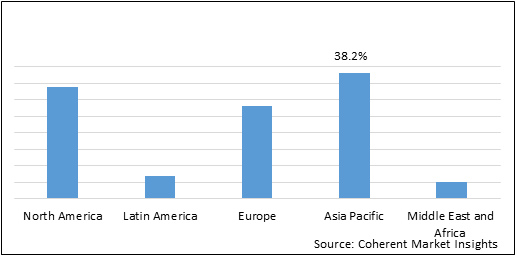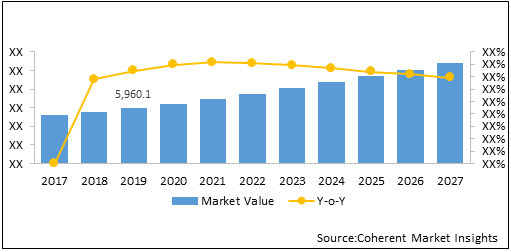Market Overview
A barcode scanner is an electronic device used to read information encrypted in the form of coded bar lines on the computer. Generally, it is used to capture the information marked on the product. In general, all barcode readers have circuitry analyzing provided by sensors. Barcode scanners consist of a light source and sensors that capture the encrypted information. 2D barcode scanners are the most popular and fast-moving barcode scanners in the market. Different technologies are used in barcode scanners including laser scanners, pent-type scanners, camera-based readers, and charge-coupled devices (CCD).
The global Barcode Scanners Market was accounted for US$ 5,960.1 Mn in terms of value and 234,51329.4 in terms of volume in 2019 and is expected to grow at CAGR of 7.6% for the period 2020-2027.
Market Dynamics- Drivers
Barcode scanners are being increasingly used in different aspects of the healthcare industry. With barcode scanners, tracking exact patient records has become sophisticated with the rectification of every possible error and reducing drug-related mistakes during a patient’s hospital stay. Moreover, according to IMNA, around 51% of medication errors can be rectified using barcode scanners technology. According to the U.S. Food and Drug Administration (FDA), there is a National Drug Code, which is a 10 digit identification number issued to every drug so that the related drug information can be easily captured and stored. Thus, these factors are expected to drive growth of the global barcode scanners market during the forecast period.
Barcode scanners are being rapidly adopted in retail and manufacturing industries. It has become one of the best solutions for product information capturing. Barcode imprinted on labels help to record information regarding product count, date of manufacturing, date of expiry for perishable products, selling price, date on which the product was supplied to retailer, etc. Major retailers such as Walmart, Costco, Carrefour, and IKEA put barcodes on all their products. This, in turn, is expected to propel the market growth over the forecast period.
Statistics:
Asia Pacific held dominant position in the global Barcode Scanners market in 2019, accounting for 38.2% share in terms of value, followed by Europe and Asia Pacific, respectively
Figure 1: Global Barcode Scanners Market Share (%) in terms of Value, By Region, 2019

To learn more about this report, Request sample copy
Barcode Scanners Market - Impact of Coronavirus (Covid-19) Pandemic
Many countries around the globe such as India, Spain and Italy have imposed nationwide lockdown. For Instance, India have imposed lockdown from 25 March to 1 June till the further notice. In this lockdown retail shops and Cinema halls in the malls will remain closed. The barcode scanners are widely used in the retail shops and Cinema halls. Moreover in India, the manufacturing facilities have to be operated in limited manpower. Owing to mentioned factors the COVID-19 is expected to restrain the growth of the market during the year 2020.
Market Dynamics- Restraints
Necessary information can be retrieved from barcode though new data cannot be fed into them. In such situations, radio frequency identification (RFID) tags are being adopted. RFID tags are similar to barcodes except information can both be retrieved and stored. Data can be fetched from RFID tags, provided the tag is present within the scanning radius of a radio scanner that does not require a straight line of sight as barcode scanners do. Moreover, RFID tags are implemented in inventory department of logistics and manufacturing units. These factors are expected to restrain growth of the market during the forecast period.
Different types of barcode scanners are available in the market to include 1D barcode scanners and 2D barcode scanners. However, the major challenge behind adoption of barcode scanners is high capital investment. Compared to 1D barcode scanners, advanced 2D barcode scanners require higher capital investment. This poses a significant challenge to most end-users, particularly in emerging economies. Thus, these factors are expected to hinder the global barcode scanners market growth in the near future.
Barcode Scanners Market Report Coverage
| Report Coverage | Details | ||
|---|---|---|---|
| Base Year: | 2019 | Market Size in 2019: | US$ 5,960.1 Mn |
| Historical Data for: | 2016 to 2019 | Forecast Period: | 2020 to 2027 |
| Forecast Period 2020 to 2027 CAGR: | 7.6% | 2027 Value Projection: | US$ 10,765.6 Mn |
| Geographies covered: |
|
||
| Segments covered: |
|
||
| Companies covered: |
JC Square Inc., Zebra Technologies Corporation, Toshiba TEC Corporation, Honeywell International Inc., Wasp Barcode Technologies, Cognex Corporation, Scandit AG, and SATO Holdings Corporation. |
||
| Growth Drivers: |
|
||
| Restraints & Challenges: |
|
||
Uncover macros and micros vetted on 75+ parameters: Get instant access to report
Market Opportunities
Businesses both SMEs and large multi-national conglomerates are both fixed assets and IT assets. It includes laptops, personal computers, office furnishings, and other required peripherals. The work of the asset management staff can be made easier if barcoding is implemented within the business. After the implementation of barcodes, all assets issued to employers are barcoded, scanned, and recorded. Although barcodes are being adopted in large enterprises, its adoption is still low and medium-scale businesses. Major companies can capitalize on these opportunities and gain a competitive edge in the market.
Market players, specifically involved in the manufacturing of barcode scanners, can capitalize on the opportunity to supply good quality products at lower costs with high reading distance. Since barcode scanners are used in multiple industries, especially in logistics and warehouse, capturing information from a long distance is very useful for time management and increasing effective business.
Figure 2: Global Barcode Scanners Market Value (US$ Mn), 2016 - 2027

To learn more about this report, Request sample copy
The global Barcode Scanners market was valued at US$ 5,960.1 Mn in 2019 and is forecast to reach a value of US$ 10,765.6 Mn by 2027 at a CAGR of 7.6% between 2020 and 2027.
Market Trends
Barcode scanners are being adopted in almost all industries. 1D barcode scanners are linear images based laser scanning devices that are used to capture the information stored in barcodes. Industries are shifting to the new 2D barcode scanners image solutions can capture 2-dimensional information as well as can scan QR codes. As a result of this, major manufacturers are focused on development of new and enhanced 2D barcode products.
Major companies in the market are focused on both organic and inorganic strategies, in order to expand product portfolio and gain a competitive edge in the market. For instance, in August 2016, Honeywell International Inc. introduced a new industrial-use barcode and label printer model, PM42, in the Middle East and India in order to help local businesses integrate printers with their network systems seamlessly, with an added feature of LCD color display supporting nine languages. Moreover, in August 2015, Zebra Technologies acquired ITR Mobility and its division factor, the software development division of ITR Group, Inc.
Competitive Section
Major companies involved in the global barcode scanners market are JC Square Inc., Zebra Technologies Corporation, Toshiba TEC Corporation, Honeywell International Inc., Wasp Barcode Technologies, Cognex Corporation, Scandit AG, and SATO Holdings Corporation.
Key Developments
Share
Share
Missing comfort of reading report in your local language? Find your preferred language :
Transform your Strategy with Exclusive Trending Reports :
Frequently Asked Questions
Select a License Type
Credibility and Certifications

860519526

9001:2015
27001:2022


Joining thousands of companies around the world committed to making the Excellent Business Solutions.
View All Our Clients
US Reciprocal Tax Impact Analysis On Barcode Scanners Market
Stay updated on tariff changes with expert insights and timely information